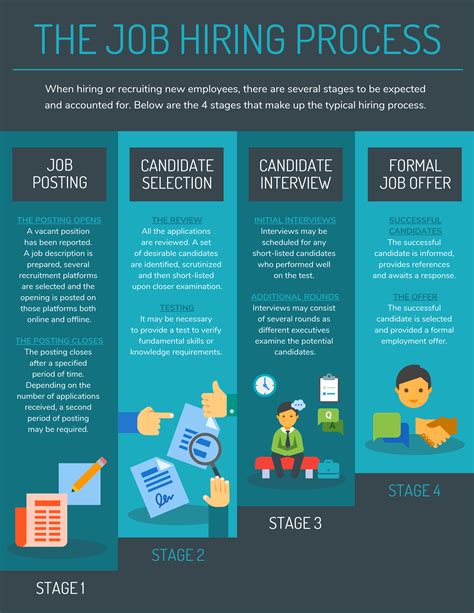Mastering The Job Application Process: A Step-By-Step Guide

Are you tired of submitting job applications and never hearing back from employers? Do you want to increase your chances of getting hired? Mastering the job application process is key to landing your dream job. In this comprehensive guide, we’ll walk you through each step of the job application process and provide practical tips to help you stand out from the competition.
1. Research the Company and Position
Before you start applying for jobs, it’s important to research the companies you’re interested in and the positions you’re applying for. Here’s how:
- Visit the company’s website and read about their mission, values, and culture.
- Check out their social media profiles to get a sense of their brand and engagement with customers.
- Read the job description carefully and make note of the required qualifications and responsibilities.
- Research the industry and competition to gain a better understanding of the company’s place in the market.
By doing your research, you’ll have a better understanding of the company’s values and expectations, which will help you tailor your application to their needs.
2. Customize Your Resume and Cover Letter
Gone are the days of submitting a generic resume and cover letter for every job you apply for. Today, employers expect applicants to tailor their application materials to the specific job and company. Here’s how:
- Use keywords from the job description in your resume and cover letter to demonstrate that you have the required skills and experience.
- Show how your previous experience aligns with the company’s values and mission.
- Highlight your achievements and quantify your results to show your impact.
- Use a professional format and design to make your application stand out.
By customizing your application materials, you’ll show the employer that you’re serious about the position and have taken the time to understand their needs.
3. Follow the Application Instructions
It may seem obvious, but it’s important to follow the application instructions provided by the employer. Here’s how:
- Read the instructions carefully and make note of any required documents or information.
- Submit your application before the deadline.
- Format your application materials according to the employer’s guidelines.
- Include a professional email address and phone number.
By following the instructions, you’ll show the employer that you’re detail-oriented and can follow directions.
4. Network with Current Employees
Networking can be a powerful tool in the job application process. Here’s how to do it:
- Connect with current employees on LinkedIn or other professional networking platforms.
- Ask for an informational interview to learn more about the company and position.
- Show your interest in the company and ask for any advice they may have for job applicants.
By networking with current employees, you’ll gain insight into the company’s culture and values, and you may even get a referral for the job.
5. Prepare for the Interview
Once you’ve submitted your application, it’s time to prepare for the interview. Here’s how:
- Research common interview questions and practice your answers.
- Dress professionally and arrive on time.
- Bring extra copies of your resume and cover letter.
- Prepare questions to ask the interviewer about the company and position.
By preparing for the interview, you’ll show the employer that you’re serious about the position and have taken the time to prepare.
6. Follow Up After the Interview
After the interview, it’s important to follow up with the employer to reiterate your interest in the position. Here’s how:
- Send a thank-you email or handwritten note within 24 hours of the interview.
- Reiterate your interest in the position and highlight any qualifications you may have forgotten to mention during the interview.
- Ask about the timeline for the hiring process and when you can expect to hear back.
By following up, you’ll show the employer that you’re enthusiastic about the position and have good communication skills.
7. Negotiate Your Salary and Benefits
Once you’ve received a job offer, it’s time to negotiate your salary and benefits. Here’s how:
- Research the average salary for the position in your industry and location.
- Consider other benefits such as health insurance, retirement plans, and vacation time.
- Prepare a counteroffer and be prepared to negotiate.
By negotiating your salary and benefits, you’ll show the employer that you’re confident in your skills and value.
Conclusion
By mastering the job application process, you’ll increase your chances of landing your dream job. Remember to research the company and position, customize your application materials, follow the instructions, network with current employees, prepare for the interview, follow up, and negotiate your salary and benefits. With these tips, you’ll be on your way to a successful job search.
FAQs
What should I include in my resume and cover letter?
Your resume and cover letter should highlight your skills, experience, and achievements that are relevant to the position. Use keywords from the job description and show how your previous experience aligns with the company’s values and mission. Quantify your results to show your impact, and use a professional format and design to make your application stand out.
How can I stand out from the competition?
To stand out from the competition, customize your application materials to the specific job and company, follow the application instructions, network with current employees, prepare for the interview, and follow up after the interview. By doing your research and showing your enthusiasm for the position, you’ll set yourself apart from other applicants.
How do I negotiate my salary and benefits?
To negotiate your salary and benefits, research the average salary for the position in your industry and location, consider other benefits such as health insurance and retirement plans, and prepare a counteroffer. Be willing to negotiate and show the employer that you’re confident in your skills and value.
